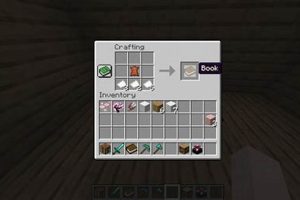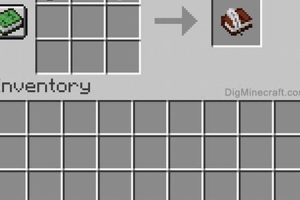The construction of a bookshelf in Minecraft involves combining wooden planks and books in a specific crafting recipe. This functional block serves a primary purpose of enhancing enchantment capabilities within the game. The crafting recipe requires six wooden planks, obtained from processing logs, and three books, created from paper and leather.
Bookshelves are crucial for maximizing the potential of enchantment tables. Enchanting is a key mechanic for improving tools, weapons, and armor, and the presence of bookshelves around an enchantment table increases the available enchantment levels. A strategically placed arrangement of bookshelves allows players to access higher-tier enchantments, significantly impacting gameplay progression. The development of the enchanting system has evolved over time, with bookshelves playing a consistently vital role.
The following sections will detail the specific materials required, the crafting process, the optimal placement for enhancing enchantment tables, and alternative methods for acquiring bookshelves within the game environment. Understanding these aspects enables players to effectively utilize this essential block.
Crafting Bookshelves
Optimizing the creation and utilization of bookshelves enhances the Minecraft experience. These tips aim to provide guidance for efficient resource management and strategic implementation of bookshelves.
Tip 1: Resource Acquisition Efficiency: Prioritize obtaining leather from cows early in the game. Establishing a cow farm significantly reduces the time spent searching for leather, a key ingredient for crafting books.
Tip 2: Wood Selection Considerations: While any type of wooden plank can be used for bookshelf construction, choose a visually appealing wood type that complements the desired aesthetic of the crafting or enchanting area.
Tip 3: Paper Production Optimization: Sugar cane, necessary for paper production, is often found near water sources. Cultivate a dedicated sugar cane farm to ensure a consistent supply of paper for book crafting.
Tip 4: Strategic Bookshelf Placement: Maintain a one-block space between the enchantment table and the bookshelves to ensure proper functionality. Obstructions such as carpets or torches negate the effect of the bookshelves.
Tip 5: Minimum Bookshelf Requirement: Fifteen bookshelves are required to reach the maximum enchantment level (level 30). Plan the layout of the enchanting area accordingly.
Tip 6: Alternative Acquisition Methods: Bookshelves can be found naturally in villages, specifically within librarian villagers’ houses. Looting these structures can provide an immediate source of bookshelves.
Tip 7: Librarian Villager Trading: Establish a trading relationship with librarian villagers. They often offer bookshelves in exchange for emeralds, providing a reliable source of bookshelves beyond crafting.
Effective bookshelf implementation is crucial for advancing in Minecraft. By following these tips, players can maximize their enchanting capabilities and resource management efficiency.
The next section will cover potential challenges and troubleshooting steps related to bookshelf functionality.
1. Plank acquisition
Plank acquisition forms the foundational element for bookshelf construction in Minecraft. The efficiency and methods employed in obtaining planks directly impact the player’s ability to create bookshelves and, consequently, to enhance their enchantment capabilities.
- Source Material: Tree Types
Different tree types yield varying amounts of logs, which, when processed, become planks. Oak, birch, spruce, jungle, acacia, and dark oak trees all serve as viable sources. The choice of tree type is largely aesthetic, as all plank types function identically for bookshelf crafting. However, location and growth speed may influence the efficiency of plank acquisition.
- Acquisition Tools: Axes and Efficiency
The speed at which trees are felled directly correlates to plank acquisition rate. Axes, particularly those crafted from higher-tier materials like iron, diamond, or netherite, significantly increase chopping speed. Enchantments, such as Efficiency, further enhance chopping speed, streamlining the plank acquisition process.
- Automated Systems: Tree Farms
For large-scale bookshelf production, automated tree farms provide a sustainable and efficient source of planks. These farms utilize observers, pistons, and bone meal to automatically harvest trees and replant saplings. While requiring initial investment in resources and redstone knowledge, automated tree farms drastically reduce the manual labor involved in plank acquisition.
- Alternative Sources: Trading and Structures
While less reliable than direct harvesting, planks can occasionally be obtained through trading with villagers or by looting structures such as shipwrecks and abandoned mineshafts. These sources offer a supplemental, albeit inconsistent, means of acquiring planks.
The speed and method of plank acquisition are intrinsically linked to the efficient creation of bookshelves in Minecraft. Optimized acquisition strategies, whether through efficient axe usage, tree farms, or alternative sources, directly contribute to a player’s ability to maximize their enchanting potential.
2. Book creation
Book creation represents a critical stage in the process of constructing a bookshelf in Minecraft. Without books, a core component of the bookshelf crafting recipe, the desired block cannot be produced, thereby limiting access to advanced enchanting capabilities. Understanding the process of book creation is therefore paramount to effectively utilizing the enchantment system.
- Paper Production: Sugarcane Cultivation
Paper, the primary ingredient in books, is crafted from sugarcane. Sugarcane cultivation necessitates planting this resource near water sources. Efficient sugarcane farms, employing automated harvesting techniques, ensure a consistent supply of paper, reducing downtime in book production. The scale of sugarcane farming directly impacts the rate at which books can be crafted.
- Leather Acquisition: Animal Husbandry
Leather, the secondary ingredient, is obtained from animals, primarily cows. Establishing a sustainable cow farm facilitates a reliable source of leather. Methods for efficient cow farming involve breeding and automated collection systems. The availability of leather directly correlates to the number of books that can be crafted.
- Crafting Recipe: Combining Resources
The book crafting recipe requires three sheets of paper and one piece of leather. Placing these items in the correct configuration within a crafting table yields a single book. The ease of this process hinges on the consistent supply of both paper and leather.
- Alternative Sources: Trading and Looting
While crafting represents the primary method of book acquisition, books can also be obtained through trading with librarian villagers or by looting structures such as libraries within strongholds. These alternative sources offer supplemental, albeit less reliable, means of acquiring books.
The effective management of resources for paper and leather production is essential for streamlining book creation. A consistent supply of books directly impacts the rate at which bookshelves can be crafted, influencing the player’s access to higher-level enchantments. Therefore, optimizing book creation is a strategic imperative within the Minecraft environment.
3. Crafting recipe
The crafting recipe is fundamental to the creation of a bookshelf within the Minecraft environment. It dictates the precise combination of resources required to transform raw materials into the desired functional block. Absence of adherence to the recipe renders the bookshelf creation impossible, thereby impeding the player’s ability to enhance enchantment capabilities.
The recipe for a bookshelf mandates six wooden planks, regardless of wood type, and three books. These items must be arranged in a specific pattern within a crafting table’s interface. Planks occupy the top and bottom rows entirely, while the books are placed in the center row. Deviation from this arrangement results in a failure to produce the bookshelf. Consider, for example, the attempt to craft a bookshelf with an incorrect placement of wood or books; the game will not recognize the intended outcome, and the recipe will fail. This emphasizes the recipe’s role as an explicit instruction set.
Mastery of the crafting recipe unlocks the capacity to improve tools, weapons, and armor via the enchanting system. The bookshelf, born from this recipe, is an essential component for achieving higher enchantment levels. Therefore, comprehension and execution of the crafting recipe directly influence a player’s progression and capabilities within the Minecraft game world.
4. Enchantment boost
The enchantment boost provided by bookshelves is intrinsically linked to the practical application of crafting them within Minecraft. The presence of bookshelves surrounding an enchantment table directly enhances the available enchantment levels, acting as a catalyst for accessing higher-tier enchantments. Without bookshelves, the enchantment table’s functionality is severely limited, restricting players to lower-level enchantments with diminished effects. Consider a scenario where a player attempts to enchant a diamond sword without any surrounding bookshelves; the enchantment options will be rudimentary, potentially offering only basic enchantments like sharpness I or knockback I. Conversely, with a full complement of bookshelves correctly positioned, the enchantment options can include significantly more powerful enchantments such as sharpness V, fire aspect II, or looting III, dramatically increasing the sword’s combat effectiveness.
The effectiveness of the enchantment boost is not merely a binary presence or absence of bookshelves. The number of bookshelves, their placement relative to the enchantment table, and the absence of obstructions between the bookshelves and the table all contribute to the overall enhancement. A specific arrangement of fifteen bookshelves, each separated from the table by a single block of air and unobstructed by torches, carpets, or other blocks, is required to achieve the maximum enchantment level. This highlights the practical significance of understanding the precise mechanics governing the enchantment boost; haphazard placement or insufficient bookshelves will result in suboptimal enchantment results, hindering player progression and diminishing the value of enchanted items.
In summary, the enchantment boost is the primary functional benefit derived from creating and strategically placing bookshelves. The correlation between bookshelves and higher-level enchantments is a direct cause-and-effect relationship. Understanding and implementing the optimal bookshelf configuration is crucial for maximizing enchantment potential, providing players with a tangible advantage in exploration, combat, and resource gathering. The challenge lies in efficiently acquiring the necessary resources and meticulously arranging the bookshelves to unlock the full potential of the enchanting system, underscoring the importance of bookshelf construction as a core component of effective gameplay.
5. Strategic placement
Strategic placement of bookshelves directly impacts their effectiveness in enhancing enchantment capabilities within Minecraft. Optimal positioning is not merely aesthetic; it is a critical factor in maximizing enchantment levels accessible through the enchantment table. A poorly arranged bookshelf setup negates the intended benefits, diminishing the player’s ability to obtain high-tier enchantments.
- Air Gap Requirement
A single block of air must exist between the bookshelf and the enchantment table for the bookshelf to contribute to the enchantment level. Obstructions, such as torches, carpets, or other blocks, placed within this space disrupt the connection, effectively rendering the bookshelf inert. For instance, if a player places a torch between the bookshelf and the enchantment table to provide light, that specific bookshelf will not contribute to the enchantment level, reducing the available enchantments.
- Bookshelf Quantity and Arrangement
Fifteen bookshelves are required to achieve the maximum enchantment level of 30. These bookshelves must be arranged symmetrically around the enchantment table, typically in a pattern that ensures each bookshelf is within two blocks of the table and separated by the required air gap. Deviations from this optimal arrangement reduce the enchantment level, forcing players to settle for less powerful enchantments. As an example, if only twelve bookshelves are placed, even if correctly positioned, the maximum achievable enchantment level will be less than 30.
- Obstruction Avoidance
Maintaining a clear line of sight between the bookshelves and the enchantment table is paramount. Any block, including transparent ones like glass panes, that obstructs this line of sight will negate the effect of the obstructed bookshelf. For example, enclosing the enchantment area with glass to create a visually appealing space must be carefully executed to avoid inadvertently blocking the bookshelf’s effect.
- Spatial Considerations
The room housing the enchantment table and bookshelves must be sufficiently sized to accommodate the required number of bookshelves and the necessary spacing. Cramped quarters may necessitate compromises in bookshelf placement, thereby reducing the overall enchantment level. For instance, if a player attempts to create an enchanting setup in a small room, they may be forced to place bookshelves in suboptimal locations, diminishing their contribution to the enchantment boost.
In conclusion, strategic placement is an integral element of how to make a bookshelf effective in Minecraft. Attention to spatial requirements, obstruction avoidance, the quantity of bookshelves, and the maintenance of an air gap are crucial for maximizing the enchantment levels available. A carefully planned and executed bookshelf arrangement transforms the enchantment table from a rudimentary tool into a powerful resource for enhancing equipment and advancing gameplay.
6. Villager trades
Villager trades offer an alternative pathway to acquiring bookshelves in Minecraft, circumventing the conventional crafting process. This avenue becomes particularly relevant when resource scarcity hinders the immediate creation of bookshelves, or when expedience is prioritized. Librarian villagers, distinguished by their white robes, routinely offer bookshelves in exchange for emeralds, the game’s primary form of currency among villagers. The quantity of emeralds demanded typically varies based on the game’s difficulty setting and the villager’s trading experience, potentially requiring multiple interactions to secure favorable exchange rates. For example, a player struggling to establish a sustainable cow farm for leather production may find trading with a librarian villager a more efficient means of obtaining the necessary bookshelves for enchantment enhancement.
The efficiency of villager trading is contingent on establishing and maintaining a thriving village economy. Curing zombie villagers to convert them into standard villagers provides a method for obtaining discounted trading rates. Furthermore, protecting villagers from threats such as zombies and pillagers is essential for ensuring their continued availability for trade. Establishing a secure village with adequate defenses and a well-managed trading system allows players to acquire bookshelves consistently, even in the absence of abundant raw materials. Consider a scenario where a player discovers a village with a librarian offering bookshelves at a reasonable emerald cost; by investing in the village’s security and establishing a reliable trading system, the player can secure a consistent source of bookshelves, enabling the construction of an effective enchanting setup without relying solely on resource gathering and crafting.
Villager trades represent a viable alternative to crafting bookshelves, providing a strategic option for resource management and expedited enchantment table enhancement. The accessibility and cost-effectiveness of these trades are influenced by the player’s investment in village infrastructure and the villager’s trading experience. Integrating villager trading into the bookshelf acquisition strategy allows for flexibility and adaptability in achieving optimal enchanting capabilities, especially in challenging game environments where resource limitations are prevalent. Securing a steady supply of bookshelves through villager trades can offer a tangible advantage, enabling players to construct effective enchanting setups that may not be feasible through conventional crafting methods alone.
Frequently Asked Questions About Bookshelf Construction in Minecraft
This section addresses common inquiries regarding the creation and effective utilization of bookshelves in Minecraft, aiming to provide clarity and actionable information.
Question 1: Is there a specific type of wood required for crafting bookshelves?
No specific type of wood is mandated. All variations of wooden planks can be used interchangeably in the bookshelf crafting recipe. The choice of wood type is purely aesthetic.
Question 2: What are the minimum resources required to craft a single bookshelf?
A single bookshelf necessitates six wooden planks and three books. The books, in turn, require three pieces of paper and one piece of leather each.
Question 3: How many bookshelves are needed to maximize the enchantment table’s capabilities?
Fifteen bookshelves are necessary to achieve the maximum enchantment level of 30. These bookshelves must be positioned correctly around the enchantment table.
Question 4: Does the placement of torches or other decorations affect the functionality of bookshelves?
Yes, any obstruction between the bookshelf and the enchantment table, including torches, carpets, or other blocks, negates the bookshelf’s effect. A one-block air gap is required.
Question 5: Can bookshelves be acquired through means other than crafting?
Bookshelves can be obtained through trading with librarian villagers or by looting specific structures such as libraries in strongholds.
Question 6: What happens if the enchanting room is too small to accommodate fifteen bookshelves correctly?
If the room is too small to accommodate fifteen bookshelves with the necessary air gap, the maximum achievable enchantment level will be reduced. A larger space is recommended for optimal enchantment.
Effective bookshelf utilization hinges on both proper crafting and strategic placement. Adherence to these guidelines ensures optimal enchantment capabilities.
The following section summarizes key considerations for bookshelf construction and implementation.
How to Make a Book Shelf in Minecraft
This exploration has detailed the fundamental aspects of creating bookshelves within the Minecraft environment. The importance of efficient resource acquisition, including wood and book components, has been highlighted. Furthermore, the article emphasized the necessity of proper crafting techniques and strategic bookshelf placement to maximize enchantment capabilities. Alternative acquisition methods, such as villager trading, provide viable options when resource constraints exist. All considerations coalesce to emphasize the bookshelf’s central role in enhancing tools, weapons, and armor.
The capacity to construct and strategically employ bookshelves is a cornerstone of advanced gameplay. Mastery of these elements empowers players to unlock higher-level enchantments, thereby facilitating progression and enhancing overall experience. Continued exploration of in-game mechanics and optimization of resource management will further refine a player’s ability to leverage the bookshelf’s full potential, yielding a tangible advantage in the Minecraft world.



![Why They Still Make Phone Books [The Truth] BoneyBooks | Discover Rare Books, Timeless Classics & Modern Reads Online Why They Still Make Phone Books [The Truth] | BoneyBooks | Discover Rare Books, Timeless Classics & Modern Reads Online](https://boneybooks.com/wp-content/uploads/2025/06/th-226-300x200.jpg)



